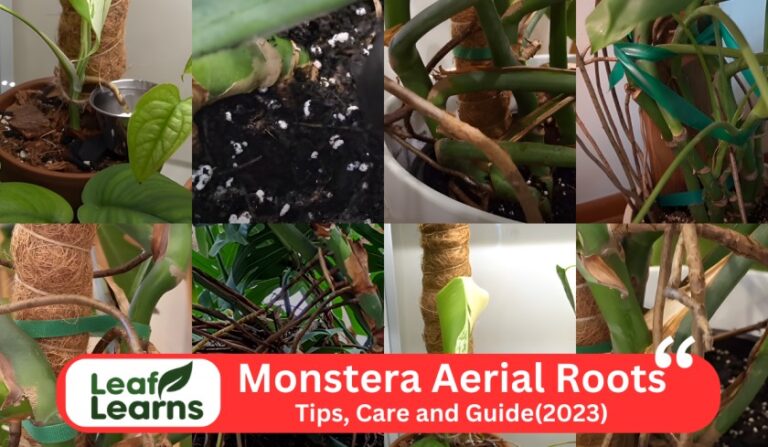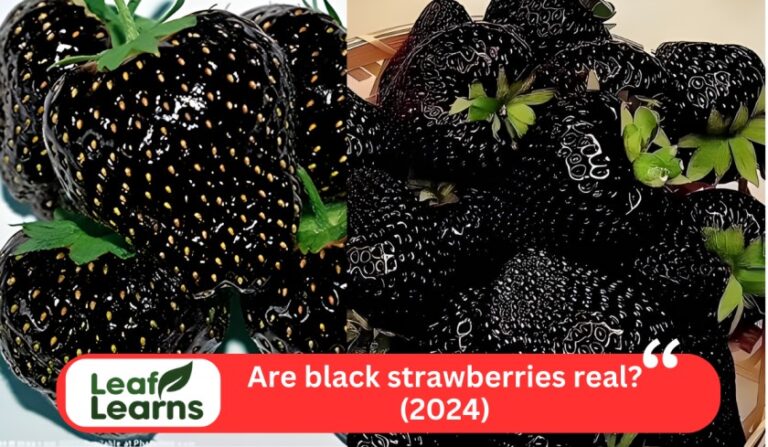13 Best Methods of Indoor Plant Propagation (2023)
Propagation is the best method to grow or multiply your favorite indoor plants Or save the your special plant to destroy. So Indoor plant propagation is process that their is no need to buy a new plant you can grow or propagate your own. So many methods of propagation are introduce to create new plant for the plant lovers. So Indoor plant propagation it is a art of generating new plant from the existing plant. It will expand your plant collection by using these all methods.
How Does it Work?
Propagation methods can vary on different plants but it involve the taking part of mature plant and then grow a new one with this help. It is a magic that the leaf or cutting may produce the new plant.
Why Do It?
There are different methods of propagation like stem cutting or leaf cutting also tissue culture but we cannot apply the methods on the same plant because every plant need a special methods for its propagation.
What You Need
Basic equipment like scissors, pots, dirt, and patience are necessary. Some techniques require supplementary equipment, such as a humidity dome or rooting hormone. However, you may begin modestly and build as your confidence grows.
The Joy of Watching Them Grow
Propagation is not a producing of new plant from the existing plant it also a magic to produce the new one and witness the miracle of life in your own home. Its a journey to produce new baby plant and need different things like water and light to make a adults one. So lets make your hand dirty with soil and make new plants
Contents
- 1 Do You Need Special Propagation Equipment?
- 2 Seed Propagation:
- 3 Stem Cuttings:
- 4 Leaf Cuttings:
- 5 Tip Cuttings:
- 6 Division:
- 7 Layering:
- 8 Offsets:
- 9 Bulb Offsets:
- 10 Rhizome or Tuber Division:
- 11 Suckers:
- 12 Grafting:
- 13 Air Layering:
- 14 Tissue Culture:
- 15 Nurturing Indoor Greenery: A Journey Through Indoor Plant Propagation
- 16 FAQs
Do You Need Special Propagation Equipment?
- Light Source
- Growing Medium
- Containers
- Humidity Control
- Sterilization Supplies
- Heat Mats
- Pruning Tools
- Labeling Materials
- Propagation Hormones
- pH and EC Meters
Seed Propagation:
Suitable for Many Species: A variety of indoor plant species may be propagated from seeds using this adaptable technique.
Starting from Scratch: Using this technique, you may see your plant’s development from a small seed into a fully grown, healthy indoor plant.
Different indoor plants:
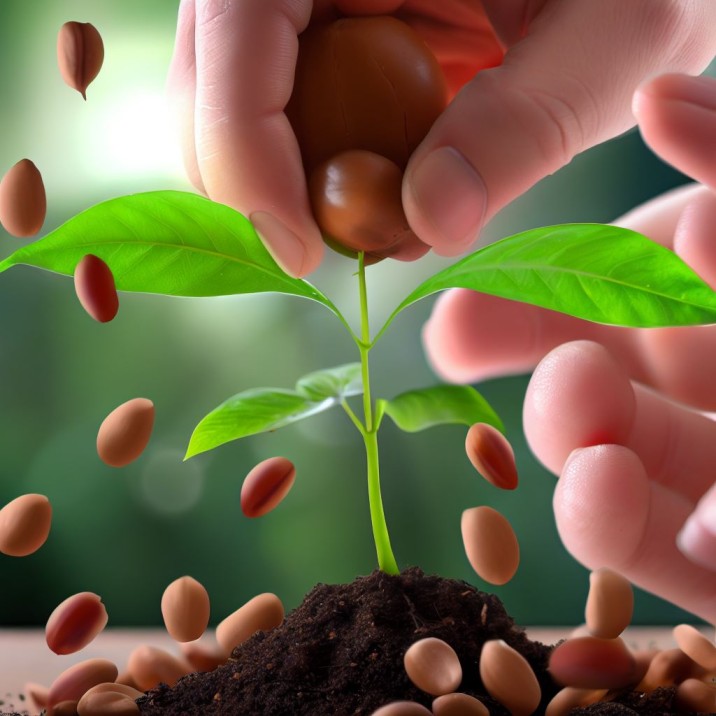
Planting Seeds: To grow plants from seeds, plant them at the optimum depth in a potting mix that drains well. You need also give the right circumstances for germination, such as enough light, moisture, and heat.
Patience is required: Compared to other techniques, seed propagation may take longer to produce mature plants, therefore it’s important to have patience and pay attention to your seedlings’ requirements.
Popular indoor plant species that can be propagated through seed:
- Peace Lily (Spathiphyllum)
- African Violet (Saintpaulia)
- Maranta (Prayer Plant)
- Lavender (Lavandula)
- Snake Plant (Sansevieria)
Stem Cuttings:
- Pick a Mature, Healthy Stem: From the parent plant, pick a mature, healthy stem. Make sure it’s clear of illnesses and pests.
- Getting Ready to Cut: To make a cut, use a clean, sharp pair of scissors or pruning shears. Just below a leaf node, where the stems and leaves converge, make a clean incision.
- Lower Leaves to be Removed: Remove the lower leaves from the cutting, leaving a few leaves at the top whole. This minimises moisture loss and promotes the development of roots.
- Rooting Hormone (Optional): To encourage the growth of roots, you can dip the cut end of the stem into rooting hormone, however this step is not always essential. This process is very useful for plants that are more difficult to root.
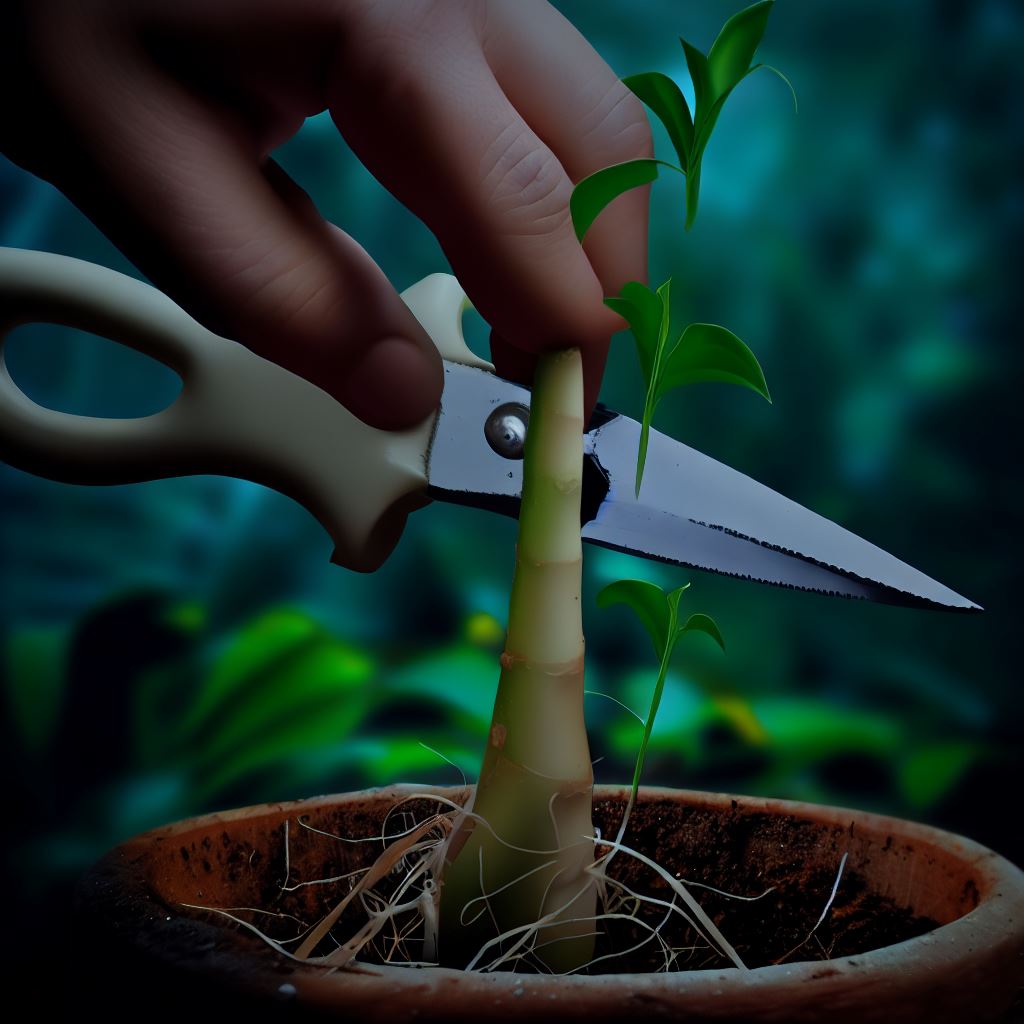
- Plant in Soil or Water: There are two major ways to propagate a cutting: either planting it directly in a potting mix that drains well or putting it in a container of water.
- Create a tiny hole in the earth with a stick or pencil for soil propagation, then insert the cutting. Put the cut end in water to facilitate water propagation, ensuring sure at least one node is submerged.
- Create the right environment by positioning the cutting in a spot with some shade. Make sure the soil is consistently wet and that the water level is high enough. Avoid overwatering since it might cause decay.
- Root Formation: The cutting will form roots over the course of several weeks to a few months. If the cutting gives way when you gently tug on it, the roots are growing.
- When the cutting has established a robust root system, it is prepared for transplantation into a bigger container with standard potting soil. Maintain it the same way you would a mature plant.
Popular indoor plant species that can be propagated through Stem Cuttings:
- Pothos (Epipremnum aureum)
- Spider Plant (Chlorophytum comosum)
- English Ivy (Hedera helix)
- Jade Plant (Crassula ovata)
- Ficus (Ficus spp.)
Leaf Cuttings:
- Pick a Mature Leaf: Pick a leaf from the parent plant that is mature and healthy. Make sure it is unharmed and disease-free.
- Construct the Cutting: To cut the leaf, use a pair of pruning shears or scissors that are clean and well-kept. Make the incision right where the leaf joins the stem, which is just below the node.
- Give the cutting time to callus: For a few days, place the leaf cutting in a dry, shady area to enable the cut end to callus. This helps keep the cutting from decaying when it is planted.
- Plant the Cutting: Plant the cutting in a well-draining potting mix after it has callused. The cut end should be buried in the ground approximately one inch deep.
- Provide Enough Moisture: Lightly water the cutting to let the soil surrounding it settle. Maintain a slightly wet soil, but refrain from overwatering to prevent rot.
- Place the potted cutting in an area with bright, indirect light to ensure proper illumination. Avoid the sun’s direct rays since they might burn the cutting.
- Observe Growth: The leaf cutting will ultimately start to sprout roots and new growth as time goes on. Be patient; it may take a few weeks to a few months to complete this procedure.
- Transplant: Once the cutting has developed roots and become a little plant, you can either relocate it to the appropriate area or transplant it into a larger pot, as necessary.

Popular indoor plant species that can be propagated through Leaf Cuttings:
- Jade Plant (Crassula ovata)
- African Violet (Saintpaulia spp.)
- Begonia (Begonia spp.)
- Peperomia (Peperomia spp.)
- Coleus (Plectranthus scutellarioides)
Tip Cuttings:
- Choose a Healthy Plant: Opt for a healthy houseplant with robust, expanding tips. Verify that it is free from illnesses and pests.
- Construct the Cutting: Take a cutting from the stem tip using clean, precise scissors or pruning shears. The cutting should have a couple sets of leaves and be around 4-6 inches long.
- Trim or pinch off the lower leaves from the cutting to remove them, leaving just a few sets of leaves at the top.
- Optional: Utilize root hormone: You can apply rooting hormone to the cutting’s cut end if you’d like. Rooting hormone is not usually required, however it can aid in root formation.
- Plant the Cutting: Add some well-draining potting soil or rooting material to a small pot or container. Bury the cutting approximately 1 to 2 inches deep in the ground. To guarantee good contact, compact the soil surrounding the cutting.
- Create a Mini Greenhouse: Cover the pot with a plastic bag or clear plastic wrap to keep a high humidity level around the cutting. It may be sealed with plant ties or rubber bands to make a little greenhouse.
- Ensure Adequate Lighting Position the container with the cutting in an area with strong, indirect light. Avoid direct sunlight since it might cause the cutting to burn. It performs nicely near a north-facing window or under fluorescent grow lights.
- Maintain Humidity: Keep an eye on the cutting to make sure the soil is always wet but not soggy. If necessary, mist the cutting to keep the plastic covering moist.
- Watch for New Growth: Over the next weeks, keep an eye out for new leaves and roots on the cutting. You may take off the plastic covering once the roots have adequately grown (typically in 4 to 8 weeks).
- Transplant: The cutting can be placed into a larger pot or its permanent container once it has developed a strong root system and is showing indications of rapid development.
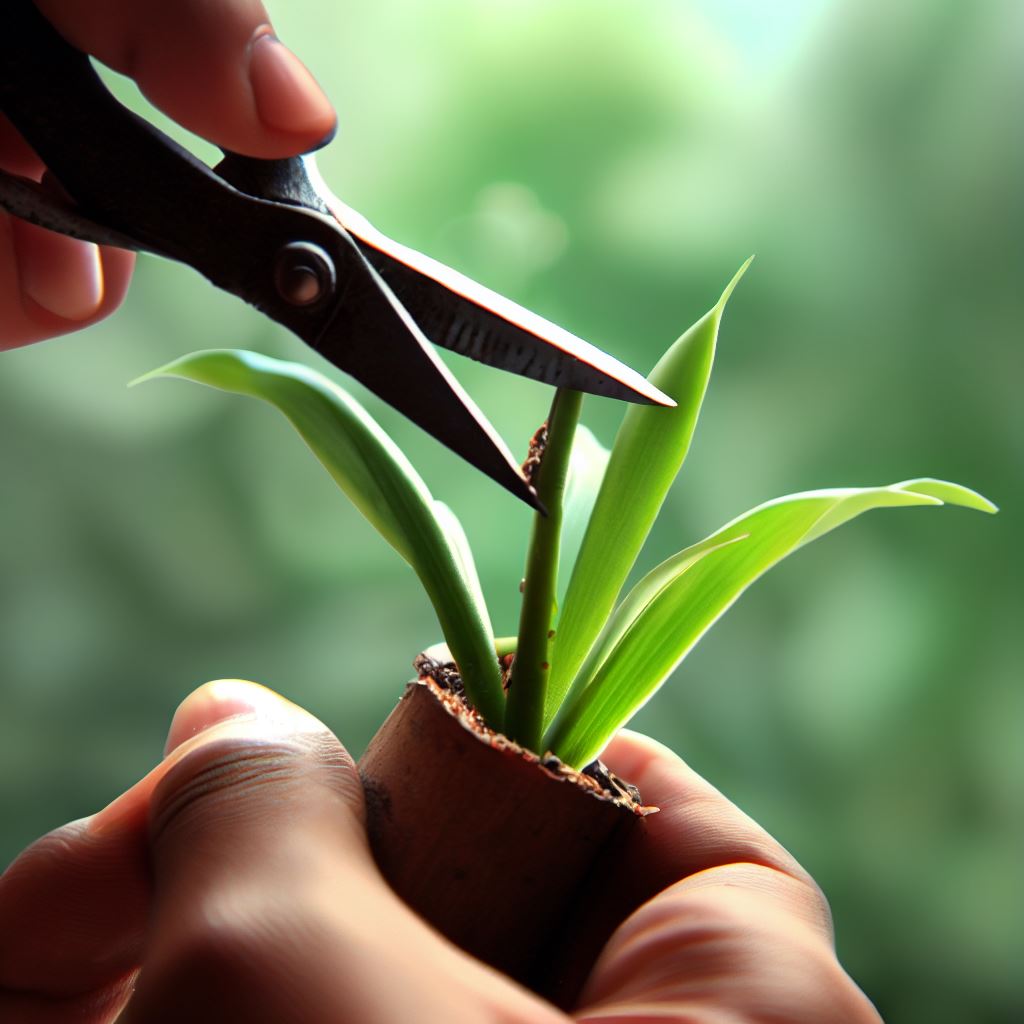
Popular indoor plant species that can be propagated through Tip Cuttings:
- Rosemary
- Lavender
- Ficus (Ficus elastica)
- Basil
- Sage
Division:
- Choose a Mature Plant: Pick an indoor plant that is mature, healthy, and has several stems or branches. Peace lilies, snake plants, Boston ferns, bird of paradise, and bamboo palms are typical division possibilities.
- Get the plant ready: Take care not to injure the roots when you carefully remove the plant from its container. Shake off any extra soil gently to reveal the root structure.
- Examine the Roots: Look at the root system to find any naturally occurring portions or divisions where you may cut the plant into smaller pieces. Look for places where the root mass begins to sprout stems or shoots.
- Divide the Plant: Carefully cut or split the plant into smaller portions using a clean, sharp knife or garden shears. Make sure that each area includes a few stems or shoots as well as a component of the root system.
- Adding the New Sections Plant each portion into a separate container with potting soil that drains properly. After potting, thoroughly water the soil to help the roots take root and settle.
- Carefully consider the position of the newly potted divisions in light of the species-specific needs of the plants. Maintain ideal humidity, light, and temperature levels for optimum development.
- Maintenance: Make sure the freshly propagated plants have enough water and nutrients by keeping a careful check on them. You can modify their maintenance practises as they develop to meet the requirements of the mature plants.

Popular indoor plant species that can be propagated through Tip Cuttings:
- Peace Lily (Spathiphyllum)
- Snake Plant (Sansevieria)
- Boston Fern (Nephrolepis exaltata)
- Bird of Paradise (Strelitzia reginae)
- Bamboo Palm (Chamaedorea seifrizii)
Layering:
- Choose a Flexible and Healthy Stem: From the parent plant that you wish to layer-propagate, choose a flexible and healthy stem.
- Choose a Node: Find a node on the selected stem. A node is a little protrusion from which branches, leaves, or flowers might sprout. The formation of roots will begin here.
- Make a Cut: Just below the node, make a small, slanting cut. Make sure the stem is chopped between one-third and halfway through.
- (Optional) Apply rooting hormone You can, but are not always required to, add a rooting hormone to the cut region to promote root formation.
- Securing the stem requires carefully bending the cut end down towards the ground. To secure it, you can use a U-shaped staple or a short length of wire.
- Plant in Soil or a container: Plant the bent section of the stem into the ground or into a container filled with well-draining soil, making sure to cover the cut node region with dirt.
- Water the soil regularly, but don’t let it become soggy. Maintain the proper humidity levels and provide indirect light for the particular plant.
- Watch for the growth of roots since they usually start at the node where the incision was done. This may need a few weeks to several months.
- Cut the baby plant gently from the parent plant when you notice enough root development, making sure it has a strong root system. Separate and pot. Fresh potting soil and a suitable container are used to plant the new plant.

Popular indoor plant species that can be propagated through Layering:
- Monstera
- Ficus
- Rubber Plant
- Philodendron
- Dracaena
Offsets:
- Select an Established Indoor Plant That Produces Offsets as the Parent Plant. The Spider Plant, Agave, Aloe Vera, Haworthia, and Sago Palm are typical examples.
- Await the Appropriate Moment:
- The best time to propagate a plant is during its active growth season. This usually occurs in the early spring or summer.
- Getting ready the parent plant:
- Make sure the parent plant is strong and healthy. Before starting the multiplication process, irrigate the plant to keep the soil wet but not soggy.
- Examine and distinguish offsets:
- Look for offsets by carefully inspecting the parent plant’s base. These are frequently little shoots or plantlets with independent roots.
- Using a pair of clean, precise scissors or pruning shears, gently detach the offsets from the parent plant.
- Potting the Offsets: Fill tiny pots with a potting mixture that drains well. Create a hole for the offset in the middle.
- Each offset should be placed in its own pot and buried at the same depth as when it was connected to the parent plant.
- Give Sufficient Care:
- Set the recently planted offsets in a spot with dappled light.
- Always keep the soil wet, but not waterlogged.
- You may treat the offsets like mature plants after a few weeks as they develop roots.
- Monitor Offset Growth: Keep an eye on the offsets that have just been potted. They can be handled as independent plants if they have grown a strong root system and are exhibiting signs of aggressive development.

Popular indoor plant species that can be propagated through offsets Method:
- Spider Plant (Chlorophytum comosum)
- Agave (Agave spp.)
- Aloe Vera (Aloe barbadensis miller)
- Haworthia (Haworthia spp.)
- Sago Palm (Cycas revoluta)
Bulb Offsets:
- Choosing Bulbs: To begin, determine which indoor plants reproduce by bulb offsets. Amaryllis, Calla Lily, Paperwhite Narcissus, Crocus, and Elephant Ear are a few typical examples.
- You must wait until the parent bulb develops offsets or baby bulbs in order to apply this procedure. Once the parent bulb has done blooming, this typically occurs.
- Separation: Remove the parent bulb and any offsets from the ground gently. Avoid damaging the roots at all costs.
- Examine and Divide: Check to see if the offsets have their own roots and branches. They can be gently separated from the parent bulb if they do.
- Planting: If you live in a climate that is suitable, plant each offset in a pot or straight into the ground in your garden. Make sure the soil drains correctly and that each particular plant kind is given the proper attention.
- The newly planted offsets should be regularly wet but not soggy. Make sure they have the right kind of light for their species.
- Growth: Depending on the species, the offsets will ultimately mature into full-grown plants that will bear their flowers or leaves.
Popular indoor plant species that can be propagated through Bulb Offsets:
- Amaryllis
- Calla Lily
- Paperwhite Narcissus
- Crocus
- Elephant Ear (Colocasia)
Rhizome or Tuber Division:
- Pick an established indoor plant with rhizomes or tubers, such a Peace Lily, an Iris, a Caladium, a Canna Lily, or a Hosta.
- Hold off until the plant is actively developing, which is often in the spring or early summer.
- Be cautious while removing the plant from its container or the ground to prevent injuring the rhizomes or tubers.
- Look over the plant’s rhizomes or tubers and locate any areas with strong roots and branches.
- Cut these parts away from the main plant using a clean, sharp knife or garden shears, making sure that each section includes both roots and shoots.
- To avoid infections, lightly dust a fungicide over the cut areas.
- In a fresh container or site with well-draining potting mix, plant each portion that has been divided.
- Place the freshly potted portions in a spot with indirect light and give them plenty of water.
- Keep the soil’s moisture levels appropriate and make sure it doesn’t get too wet.
- The separated areas will eventually establish themselves as separate plants and develop into lovely additions to your indoor garden.
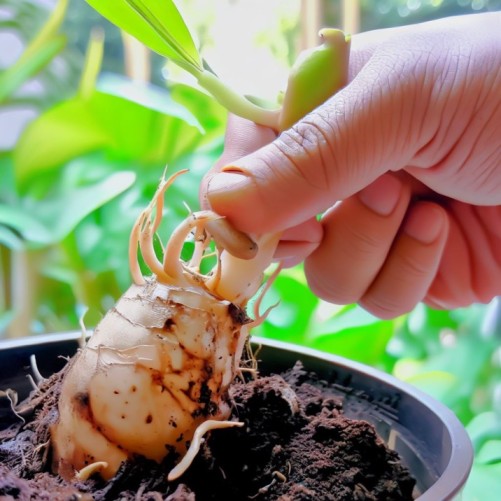
Popular indoor plant species that can be propagated through Rhizome or Tuber Division:
- Peace Lily (Spathiphyllum)
- Iris
- Caladium
- Canna Lily (Canna indica)
- Hosta
Suckers:
- The simple technique of suckers is frequently employed to reproduce some indoor plants. Small branches or offshoots known as suckers appear at the parent plant’s base. The following plants may be treated using this technique, which is rather simple:
- Cast iron plant at Aspidistra: Simply remove the little branches or suckers from the parent plant to reproduce aspidistra by suckers. These may be cultivated into separate plants by being planted in a fresh container.

Popular indoor plant species that can be propagated through Suckers:
- Snake Plant (Sansevieria)
- Hosta
- Agave
- Spider Plant (Chlorophytum comosum)
Grafting:
- Choose a Scion and healthy stocks: Select a sound, well-established plant (stock) and the desired variety to be grafted onto it (scion).
- Construct a stock plant: On the stem or branch of the stock plant, make a precise, diagonal cut.
- Prepare the scion plant by cutting a comparable diagonal portion, making sure the diameter matches the stock.
- Join Scion and Stock: Align the cambium layers (the inner greenish layer) before joining the two cut surfaces.
- Protected Graft: To keep the stock and scion securely in place, grafting tape or rubber bands should be used to bind the graft union.
- Establish Ideal Conditions: To promote healing and growth, place the grafted plant in a warm, humid location, frequently in a greenhouse or beneath a plastic bag.
- Observe Growth: The scion should develop and meld with the stock plant over time. When growth becomes apparent, cut off any undesirable branches from the stock.
- Grafted Plant Transplant: After the graft has joined successfully, move the grafted plant into a suitable pot or container filled with soil that drains quickly.

Popular indoor plant species that can be propagated through Grafting:
- Citrus Trees
- Mango Trees
- Ficus Trees
- Avocado Trees
- Guava Trees
Air Layering:
- Pick a Healthy Branch: From the parent plant that you wish to multiply, pick a healthy branch. It should be a young stem, usually from the growth of the most recent year.
- Branch preparation: About a foot or so below the branch’s tip, or where you want the roots to develop, make a horizontal incision through the branch’s outer layer of bark that is 1 to 2 inches wide.
- Application of Rooting Hormone: Treat the cut area with a rooting hormone. Your odds of success go up when rooting hormone is present.
- Wrap the cut part in a wet substrate, such as sphagnum moss or a combination of peat moss and perlite. This keeps the region moist and encourages root growth.
- Cover with Plastic Wrap: Place a sheet of transparent plastic wrap or a plastic bag over the moss or substrate and fasten it securely above and below the incision. For the sliced portion, this provides a sealed, humid environment.
- Monitor and Water: Make sure the substrate is kept consistently wet but not flooded by checking the moisture level on a regular basis. If required, add water.
- Root Formation: Within the moss or substrate, roots should start to develop over the course of a few weeks to a few months. Pulling lightly on the branch will generally reveal the presence of roots. Resistance indicates the presence of roots.
- Once roots have adequately grown, carefully cut the new plant part below the rooted region and pot it. Take away the plastic.
- The freshly rooted plant should be potted in a suitable potting medium and given the same attention as any other indoor plant. Keep it in a setting that offers the right amount of light, heat, and humidity for the particular plant.
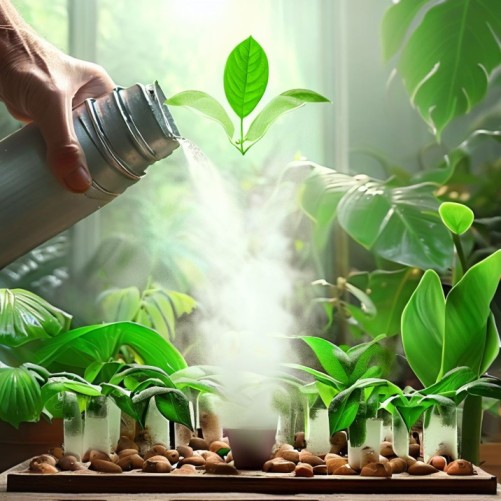
Popular indoor plant species that can be propagated through Air Layering:
- Rubber Plant (Ficus elastica)
- Monstera (Monstera deliciosa)
- Ficus (Ficus spp.)
- Dracaena (Dracaena spp.)
- Philodendron (Philodendron spp.)
Tissue Culture:
- A healthy, disease-free plant specimen should be used as the source for tissue culture. A leaf, stem, or bud is typically chosen as the little bit of plant tissue that will be used in the propagation process.
- Surface sterilisation: To get rid of any impurities, the selected plant material is put through a surface sterilisation procedure. To make tissue culture successful, this is essential. Bleach or ethanol solutions are two frequently used sterilisation techniques.
- Launch of Explants: The sterilised plant material, sometimes known as “explants,” is put in a sterile container like a petri dish together with a nutrient-rich agar substrate. The explants may develop because the medium has the hormones and nutrients they need.
- Subculturing: To promote the growth of the explants, they are frequently moved to new nutritional media as they get bigger. Changing hormone concentrations may be necessary during this process to support particular development stages.
- Micropropagation: Once the explants have grown into tiny plantlets or “shoots,” micropropagation can be used to increase their number. In order to do this, the shoots must be cut into smaller pieces, each of which can sprout a new plant.
- Acclimatisation: The freshly propagated plants are acclimated to the environmental conditions outside the lab after successful multiplication. This is an essential phase in getting them ready for life in a typical indoor setting.
- Finally, the tissue-cultured plants are prepared for transplantation into separate pots or containers, where they can develop and flourish further.
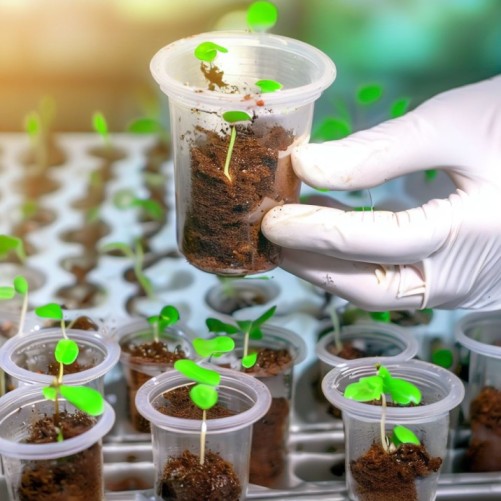
Popular indoor plant species that can be propagated through Tissue Culture:
- Orchids
- Carnivorous Plants
- Bromeliads
- Ferns
- Rare Succulents
Nurturing Indoor Greenery: A Journey Through Indoor Plant Propagation
In the world of indoor gardening and plant propagation, enthusiasts have access to a wide array of tools and techniques. Whether you’re a beginner or a seasoned pro, there’s something for everyone. From the lush propagation of Anthuriums to the delicate art of Begonia and Bird of Paradise indoor plant propagation, there’s an indoor plant propagation app to assist you.
For those looking to add some tropical flair to their space, consider exploring the wonders of indoor bamboo plant propagation or the vibrant Coleus plant indoor propagation. If you prefer a touch of the exotic, delve into the realm of Elephant Ear and Purple Heart plant propagation.
Hydroponics and water propagation for indoor plants offer innovative ways to nurture your green companions, while kits and calculators simplify the process. English Ivy, Rubber Plants, and Yuccas all find a place in this propagation journey.
With guidance on indoor plant propagation techniques and a list of indoor plants that thrive when propagated in water, your indoor garden in Islamabad, Karachi, Lahore, or anywhere in Pakistan is poised to flourish. Whether you’re a seasoned indoor gardener or just beginning, these tools and techniques make it easier than ever to grow your indoor oasis.
FAQs
What is indoor plant propagation?
Growing new plants from older ones is a method known as indoor plant propagation. It uses a variety of techniques, including as taking cuttings or utilising plant tissues, to develop new, wholesome indoor plants.
Why would someone want to propagate indoor plants?
Plant lovers may increase their plant collections, protect prized species from harm or illness, and share plants with friends and family without having to purchase new ones by propagating indoor plants.
What are some common methods of indoor plant propagation?
Stem cuttings, leaf cuttings, division, layering, offsets, and bulb offsets are typical means of plant multiplication. These techniques are appropriate for various indoor plant species and skill levels.
What equipment or tools are necessary for indoor plant propagation?
Snips, pots, appropriate soil or growth media, and containers with sufficient drainage are all basic instruments for propagation. Depending on the technique, you could additionally require humidity domes, rooting hormone, or specific illumination.
Can anyone propagate indoor plants, or does it require specialized knowledge?
The majority of indoor plant propagation techniques are user-friendly for novices. Anyone can master indoor plant propagation with a little reading and practise. However, more specialised expertise and tools could be needed for more sophisticated techniques, such as tissue cultivation.


